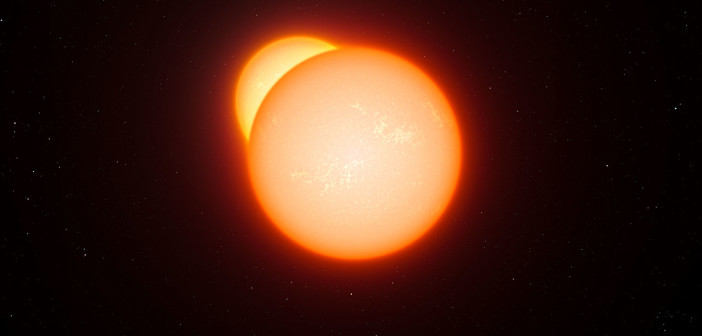In KIC 9246715, two red-giant stars — twins in nearly every way — circle each other in a 171-day orbit. This binary pair may be a key to learning about masses and radii of stars with asteroseismology, the study of oscillations in the interiors of stars.
Two Ways to Measure
In order to understand a star’s evolution, it is critical that we know its mass and radius. Unfortunately, these quantities are often difficult to pin down!
One of the few cases in which we can directly measure stars’ masses and radii is in eclipsing binaries, wherein two stars eclipse each other as they orbit. If we have a well-sampled light curve for the binary, as well as radial velocities for both stars, then we can determine the stars’ complete orbital information, including their masses and radii.
But there may be another way to obtain stellar mass and radius: asteroseismology. In asteroseismology, oscillations inside stars are used to characterize the stellar interiors. Conveniently, if a star with a convective envelope exhibits solar-like oscillations, these oscillations can be directly compared to those of the Sun. Mass and radius scaling relations — which use the Sun as a benchmark and scale based on the star’s temperature — can then be used to derive the mass and radius of the star.
Test Subjects from Kepler
![Solar-like oscillations from KIC 9246715 are shown in red across different resonant frequencies. The oscillations of a single red-giant star with similar properties are shown upside down in grey for reference. [Rawls et al. 2016]](https://aasnova.org/wp-content/uploads/2016/02/fig25-260x128.jpg)
Solar-like oscillations from KIC 9246715 are shown in red across different resonant frequencies. The oscillations of a single red-giant star with similar properties are shown upside down in grey for reference. [Rawls et al. 2016]
In a recent study led by Rawls, the team analyzed the first of these binaries, KIC 9246715. Using the Kepler light curves in addition to radial velocity measurements from high-resolution ground-based spectroscopy at the Fred Lawrence Whipple Observatory and Apache Point Observatory, Rawls and collaborators established that the two stars have masses of 2.17 and 2.15 solar masses, and radii of 8.4 and 8.3 solar radii.
Not Quite Twins?
Intriguingly, when the authors measured the stellar oscillations from the binary, they were only able to pick out one signal. Using the scaling relations, their measurements reveal that the star producing the oscillations has a mass of 2.17 solar masses and radius of 8.3 radii — consistent with both red giants in the system, within error bars. This provides excellent confirmation of the scaling relations for obtaining mass and radius, but it also raises a new question: why is only one star of this twin system producing oscillations?
Rawls and collaborators have an idea: one star might be more magnetically active than the other, causing the suppression of oscillations in the more active star. The authors’ observations and detailed modeling support this idea, but similar analyses of the rest of the red-giant eclipsing binaries identified in the Kepler field will help to determine if KIC 9246715 is unusual, or if this behavior is common among such systems.
Citation
Meredith L. Rawls et al 2016 ApJ 818 108. doi:10.3847/0004-637X/818/2/108


2 Comments
Pingback: testing astroseismology as a means of measuring stars
Pingback: Midiendo gigantes rojas « SEDA / LIADA